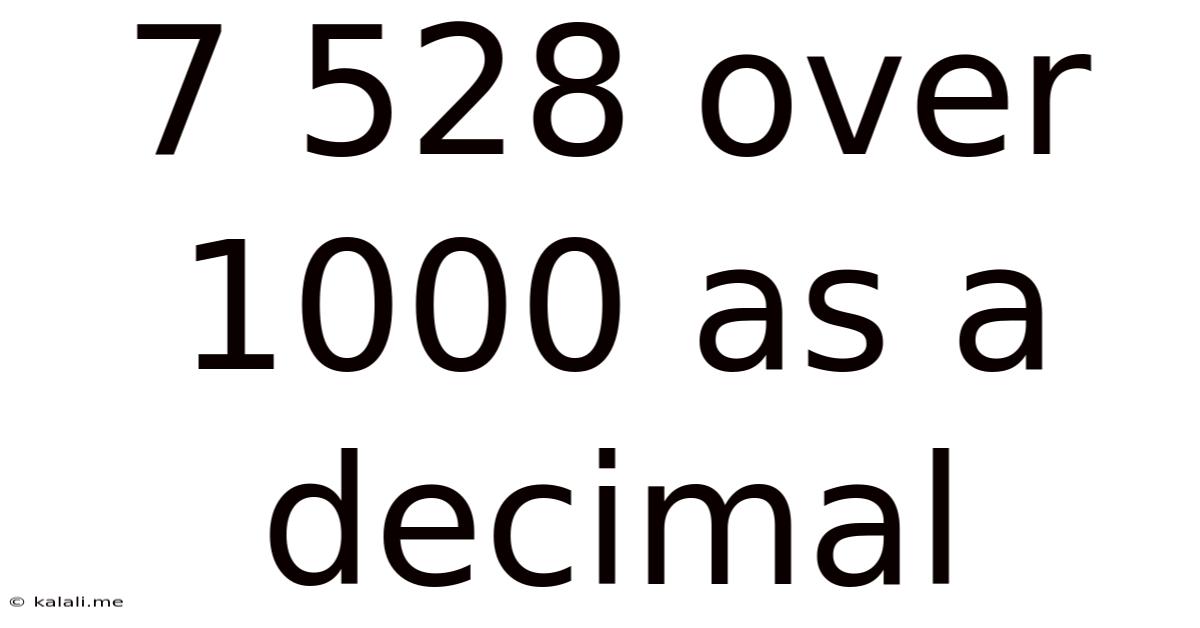7 528 Over 1000 As A Decimal
Kalali
Jul 02, 2025 · 4 min read

Table of Contents
7528 over 1000 as a Decimal: A Comprehensive Guide to Fraction-to-Decimal Conversion
This article comprehensively explores the conversion of the fraction 7528/1000 into its decimal equivalent. We'll delve into the fundamental principles of fraction-to-decimal conversion, explore different methods for solving this specific problem, and discuss the broader applications of understanding this type of conversion in various mathematical contexts. This guide is designed for anyone from students needing to grasp this fundamental concept to individuals seeking a refresher on decimal representation.
Understanding Fractions and Decimals:
Before diving into the conversion process, let's establish a clear understanding of fractions and decimals. A fraction represents a part of a whole, expressed as a ratio of two numbers – the numerator (top number) and the denominator (bottom number). A decimal is another way to represent a part of a whole, using a base-ten system where the digits to the right of the decimal point represent tenths, hundredths, thousandths, and so on.
The core concept in converting a fraction to a decimal is to express the fraction as a number divided by a power of 10 (10, 100, 1000, etc.). This is because the decimal system is inherently based on powers of 10.
Methods for Converting 7528/1000 to a Decimal:
There are several ways to convert the fraction 7528/1000 to a decimal. Let's explore the most common and straightforward methods:
Method 1: Direct Division
The most fundamental method involves performing long division. Divide the numerator (7528) by the denominator (1000):
7.528
1000|7528.000
7000
-----
5280
5000
-----
2800
2000
-----
8000
8000
-----
0
Therefore, 7528/1000 = 7.528
This method is reliable and provides a clear understanding of the underlying process. However, it can be time-consuming for larger numbers or fractions with more complex denominators.
Method 2: Utilizing Decimal Place Value
Because the denominator is 1000 (10³), a power of 10, we can directly convert this fraction to a decimal by moving the decimal point. Since 1000 has three zeros, we move the decimal point of the numerator three places to the left.
The number 7528 can be written as 7528.0. Moving the decimal point three places to the left gives us 7.528.
This method is particularly efficient when the denominator is a power of 10. It’s a quicker alternative to long division for these specific cases.
Method 3: Simplifying the Fraction (If Possible)
Before converting, it's always beneficial to simplify the fraction if possible. In this case, we can simplify 7528/1000 by finding the greatest common divisor (GCD) of 7528 and 1000. The GCD of 7528 and 1000 is 8. Dividing both the numerator and denominator by 8, we get:
7528 ÷ 8 = 941 1000 ÷ 8 = 125
This simplifies the fraction to 941/125. While this simplification is possible, it doesn't significantly simplify the decimal conversion process in this particular instance. Direct division or the decimal place value method remains more efficient.
Understanding the Decimal Result: 7.528
The decimal representation 7.528 signifies seven and five hundred twenty-eight thousandths. Each digit after the decimal point represents a decreasing power of 10:
- 7: represents the whole number part.
- .5: represents five tenths (5/10).
- .02: represents two hundredths (2/100).
- .008: represents eight thousandths (8/1000).
Practical Applications and Extensions:
Understanding fraction-to-decimal conversions is crucial in numerous real-world applications and mathematical contexts:
- Financial Calculations: Converting fractions to decimals is essential in calculating percentages, interest rates, and other financial computations.
- Scientific Measurements: Scientific measurements often involve fractions that need to be converted to decimals for easier analysis and comparison.
- Engineering and Design: Precision in engineering and design requires accurate conversions between fractions and decimals.
- Data Analysis: Data analysis frequently involves working with decimal representations of data.
- Programming and Computing: Many programming languages and software applications rely on decimal representation for numerical computations.
Beyond the Basics: Recurring Decimals and Irrational Numbers
While 7528/1000 yields a terminating decimal (a decimal that ends), not all fractions convert to terminating decimals. Some fractions result in recurring decimals (decimals with a repeating pattern of digits), such as 1/3 = 0.3333... Understanding the difference between terminating and recurring decimals is vital for working with various types of fractions.
Furthermore, some fractions, such as the square root of 2 (√2), cannot be expressed as a fraction or as a terminating or recurring decimal. These are known as irrational numbers. These numbers have infinite non-repeating decimal expansions.
Conclusion:
Converting 7528/1000 to its decimal equivalent (7.528) is a straightforward process achievable through long division, leveraging the decimal place value system, or potentially through fraction simplification (although less efficient in this specific case). Understanding this conversion is fundamental for various mathematical applications and real-world scenarios. This article provided multiple methods to ensure a thorough understanding of the conversion process and its broader implications in various fields. The ability to confidently convert fractions to decimals is an invaluable skill in numerous disciplines. Remember to always consider the context and choose the most efficient method based on the specific problem.
Latest Posts
Latest Posts
-
2 Cu Ft Is How Many Pounds
Jul 31, 2025
-
What Type Of Water For Betta Fish
Jul 31, 2025
-
John Deere Oil Filter Am125424 Cross Reference Chart
Jul 31, 2025
-
How Is Grendel Characterized In This Excerpt
Jul 31, 2025
-
I Was Born In 1971 How Old Am I
Jul 31, 2025
Related Post
Thank you for visiting our website which covers about 7 528 Over 1000 As A Decimal . We hope the information provided has been useful to you. Feel free to contact us if you have any questions or need further assistance. See you next time and don't miss to bookmark.